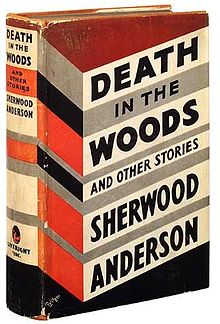- Death in the Woods
-
Death in the Woods is a short story by Sherwood Anderson first published in 1924 and reprinted in 1933. "Death in the Woods" is a "retelling" of events from the narrator's childhood, as he attempts to explain a death and its relationship to other lives. The narrator(s) in each story are generally unreliable, but Anderson is attempting to portray dysfunctional narrators who are trying to find meaning and beauty in the everyday life of common people. His circular story-telling technique makes for a fascinating read. Not only do his individual stories follow this technique, but the entire book follows it, as well. For example, the first story "Death in the Woods" is about the death of an old woman. The narrator, looking back, tries to organize his memories and create a meaning and beauty out of them. Rather than remembering an aged woman, he remembers a beautiful, "statuesque" and almost marble figure. The last story is about a dysfunctional family who experiences death in various ways- a potential physical death of a son and a rather more serious death that is not physical. It reflects on family relationships and how "enemies" among the family constantly occur, for example, a mother-daughter or father-son enmity.
Contents
Plot
"Death in the Woods" is presented as a first-person narrative by an unreliable narrator, who tells the story of an old woman, Mrs. Grimes. Mrs. Grimes lives on the edge of society and survives by selling eggs and using the proceeds to buy food for herself, her small family and the animals in her care. Her husband is considered to be a horse thief, and the couple is looked down on by others.
Mrs. Grimes' personal history, according to the narrator, is that she was abandoned by her mother and grew up as an (Indentured servant). It is suggested that there she received inappropriate attentions from her German master. The master's wife was suspicious and perhaps cruel toward her. Mrs. Grimes agrees to marry Jake Grimes, who "helps" her escape her German master and his wife.
Mrs. Grimes and Jake Grime have a son and a daughter, but the daughter died in childhood. The narrator tells us that their son grows up to be like his father. Both of them verbally abused Mrs. Grimes and treat her in a manner similar to the way the German and his wife had treated her. She does not know life could be any different as this is all she ever experienced, according to the narrator. Her main concern in life is taking care of, and feeding the animals and people in her care. Her duty, she feels, is to feed animal life.
On the last day of her life, Mrs. Grimes walks into town to trade some eggs and buy some meager supplies. Her dogs follow her into town. According to the narrator, the butcher was unusually friendly and compassionate on this visit (because of the snowy, cold weather), giving her some extra liver and speaking to her kindly. She begins her walk home late in the day.
On her way home, she leaves the road and walks through the woods, probably a short cut. On this shortcut she reaches a clearing where she sits down to rest. While sitting down, she dies. The dogs, that had been following her, run around her in circles, then rip the pack away from her and devour the food inside.
The body is discovered by a hunter, who goes into town and tells everyone about the body in the woods. A group of men and some boys, including the narrator, walk into the woods to examine the body and bring it back.
When the narrator and his brother return home, the older brother tells the story. Our narrator set down his version of the story many years later, because he felt that his brother had not been able to properly and efficiently explain the events.
There are other stories that are re-tellings of events or stories told by unreliable narrators- meaning they do not necessary give readers accurate, cold-hard facts. The stories are from their points-of-view, or how they interpret the events or happenings. It is their "working out" of their past experiences.
Analysis
The narrator's ability to understand the events is suspect because he was a young boy when the body of the old woman was found. The narrator has also had experiences in his life that mimic the events he attributes to the old woman. The difference between reality and the events described by the narrator are suspect. The author uses phrases like "He did not say anything actually" to indicate the narrator wasn't aware of what really happened. The narrator also questions his own knowledge, saying "I wonder how I know all this."
The narrator relates that when he was a young man he worked on the farm belonging to a German and that the hired girl was afraid of her employer. The hired-girl was also hated by the farmer's wife. It is implied that this memory is turned into the experience of Mrs. Grimes whom he describes as growing up and working for a German farmer and his wife. In the narrator's version of events, Mrs. Grimes even tells her husband "that nothing really ever happened, but he didn't know whether to believe it or not."
Another part of the story that might be created from the narrator's life experience is the way the dogs circle the old woman as she lay dying in the woods. The narrator describes that he himself had an experience where dogs ran in circles around him in the woods. This is why he comes to the conclusion that this must be what happened to Mrs. Grimes. He explains what he believes happened to her by relating it to the direct experience of what happened to him. In doing so, he creates a story that has meaning and beauty for him. The entire reason of re-telling her story is to sort through his memories and find a reasonable explanation or understanding of previous events.
Symbolism and literary technique
The dogs running in a circle around Mrs Grimes is presented as a death ritual.
Silence and a lack of dialogue form a significant part of the story. This lack of dialogue alludes to how little of the narrator's version of Mrs Grimes' story is based on fact. The narrator uses phrases like: "He did not say anything actually", "She had got the habit of silence anyway...", "No one ever talked to her in town" or "Whatever happened she never said anything." These combine to confirm how little factual evidence the narrator has used to tell his story.
Rather than telling the story on a linear "playing field," Anderson uses a circular story-telling technique. The narrators try to work out their memories, past experiences, and stories they've heard previously in a way that connects them to create a kind of meaning. The information isn't meant to be factual. Anderson is attempting to find meaning and beauty in the life of a simple woman. He finds beauty in the everyday (and even grotesque) life of common (and eccentric) people, which is a theme that runs throughout the stories in "Death in the Woods and Other Stories."
Short story collections
Earlier collections, (anthologies), of Anderson's stories included Winesburg, Ohio, A Group of Tales of Ohio Small Town Life (1919) [1] The Triumph of the Egg (1921),[2] and Death in the Woods (1933). [3] and Horses and Men (1923).[4] A more recent collection would be Certain Things Last: The Selected Short Stories of Sherwood Anderson.[5] Death in the Woods can also be found in American Gothic Tales edited by Joyce Carol Oates.[6]
The original book and book cover are among the rarest in American publishing. This is due to the fact that the printing of the was interrupted when the publisher went into bankruptcy.
References
7. <http://www.csustan.edu/english/reuben/pal/chap7/anderson.html>
8. <http://www.enotes.com/death-woods/summary>
9. <http://www.bookrags.com/studyguide-deathwoods/sum.html>
External links
Works by Sherwood Anderson Novels Marching Men (1917) · Poor White (1920) · Many Marriages (1923) · Dark Laughter (1925)

Short story
collectionsWinesburg, Ohio (1919) · Death in the Woods (1924)
Categories:- American short story collections
- Anthologies
- 1924 short story collections
- Fiction with unreliable narrators
Wikimedia Foundation. 2010.

